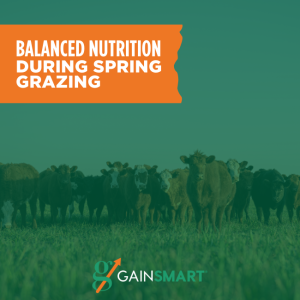
Grazing cows on wheat pasture is a common practice where wheat is an economical source of gain throughout the Southern Plains and Midwest. Many high-quality nutrients are available in wheat pasture for late fall and winter grazing.
It is more common to turn stockers out on wheat pasture. However, grazing cows or pairs on wheat pasture is often a way producers can best use the resources available to them.
Cattle Nutrition Experts
Curious about who you’re getting advice from? Gain Smart® is a renowned brand of mineral supplements designed to enhance cattle health, optimize growth and improve feed efficiency. Our products support commercial producers looking to maximize their operations. Best of all, Gain Smart products ensure balanced nutrition for livestock.
BioZyme® Inc., a leading fermentation company pioneering advancements in animal nutrition and health, developed the Gain Smart brand. Through innovative research and high-quality manufacturing, BioZyme creates powerful solutions that improve animal performance and support producer profitability in the agricultural industry.
Our mission: undeniable positive impact on the health and wellness of your animals and your business.
Benefits of Grazing Wheat Pasture
Grazing cows on wheat pasture provides several advantages to both the cattle and the producer. These benefits can positively impact performance, health and overall productivity. Our BioZyme team wants to share the benefits with you so you can maximize the potential of your operation.
Nutritional Benefits
Wheat pastures provide a high-quality forage that is rich in protein and energy, promoting weight gain and milk production in cattle. This makes it a valuable resource, particularly during the late fall and winter when other forages may be scarce. Feeding cattle in winter can be challenging, but wheat pasture offers a nutritional alternative.
Cost Savings
Grazing cows on wheat can reduce feed costs by eliminating the need for purchased hay or grain. Producers can optimize resources by using their existing land for dual purposes—growing wheat for grazing and eventual grain harvest.
Soil Health & Weed Control
Grazing can improve soil conditions by enhancing organic matter through manure deposition and stimulating root growth in wheat through controlled grazing. Maintaining a vegetative cover on the land through grazing can help reduce soil erosion, especially during the winter and early spring when erosion risks are higher. Additionally, cows help suppress weed populations by consuming a variety of plants, reducing the need for chemical herbicides.
Disadvantages of Grazing Wheat Pasture
Just like most things in life, we must take the bad with the good. Although there are nutritional, economic and environmental advantages to grazing cows on wheat pasture, disadvantages also exist.
Overgrazing Risks
Uncontrolled grazing can damage wheat plants, reducing grain yields and compromising future planting cycles. Proper management is essential to balance forage use and crop productivity.
Soil Compaction
Frequent trampling by cattle, especially in wet conditions, can compact the soil, limiting water infiltration and root development. This may harm both the wheat crop and future plantings. Proper management practices, such as rotational grazing and avoiding overgrazing, are necessary to maintain soil and plant health.
Health Concerns for Cattle
Wheat pasture can lead to health issues like bloat and grass tetany in cows if not properly managed. Supplements may be required to prevent deficiencies. Bloat is another concern that should be monitored.
Management Intensity
Grazing wheat requires careful monitoring of cattle stocking rates, grazing duration and pasture condition. This adds labor and planning demands. Maintaining secure fencing is essential to keep cattle within designated grazing areas and prevent them from straying, especially in extensive pasture systems. In addition to having secure fences, cattle need to have continuous access to clean water.
While grazing cows on wheat pasture can be highly beneficial, it requires careful management to address the potential challenges. By being aware of these issues and implementing appropriate strategies, producers can optimize the use of wheat pasture to support the health and growth of their cattle.
Let Gain Smart Work for You!
Gain Smart is a line of vitamin and mineral supplements for stocker cattle that promotes healthy, economical pounds. Gain Smart offers 4 different free-choice vitamin and mineral supplement formulas to fit any feeding scenario. We even offer one specially designed for grazing wheat pasture.
The 4 Gain Smart formulas include:
- Gain Smart Stocker, designed to maximize efficient gain.
- Gain Smart Stocker Wheat, designed to maximize efficient gain on wheat or small grain pasture.
- Gain Smart Stocker HEAT®, designed to maximize efficient gain when temperatures are above 70 degrees Fahrenheit. Contains HEAT technology, a combination of essential oils and garlic, to support animals when heat and insects are a challenge.
- Gain Smart Stocker Balancer RU1600, designed to maximize efficient gain and balance high grain diets when mixing TMR rations. Includes rumensin for improved feed efficiency.
The Gain Smart Difference
All formulas offer the following key benefits:
- Powered by AO-Biotics® Amaferm®, a prebiotic research-proven to enhance digestibility.
- Include organic copper, iodine and zinc for maximum bioavailability and hoof health.
- Provide nutritional support for a healthy immune system.
Keep your Cows Healthy on Wheat Pasture
Have we convinced you that Gain Smart powered by Amaferm is the best supplement for wheat pasture? We hope so! Now that you know about Gain Smart, you can supplement your herd and still feel comfortable grazing cows on wheat pasture.
Gain Smart is available at any of our local BioZyme Dealers. Locate the dealer nearest you.
Would you like to receive more information about keeping your cattle gaining healthy, efficient pounds? Sign up for our newsletter.

